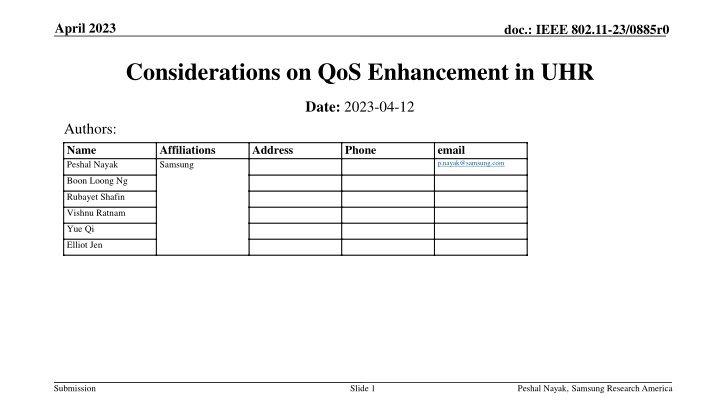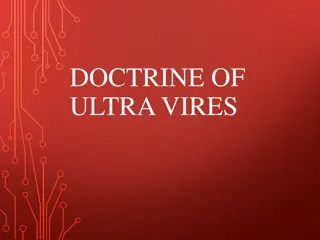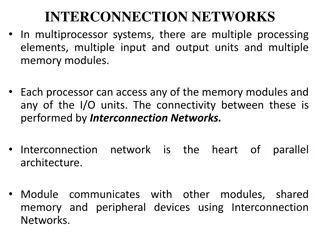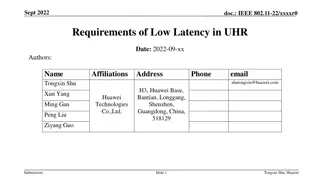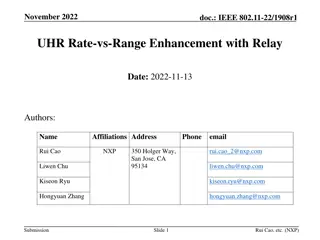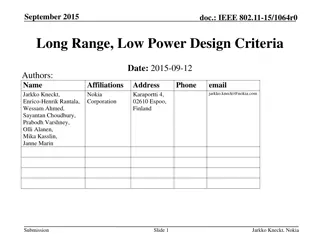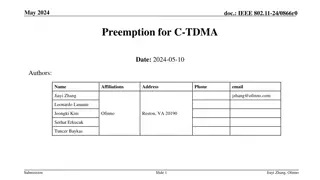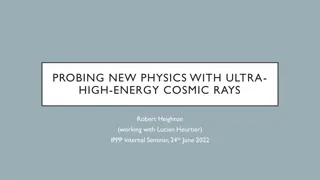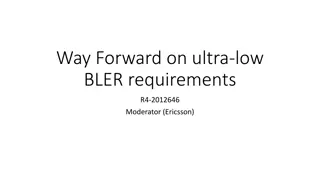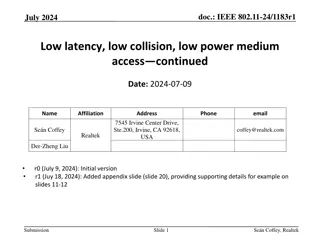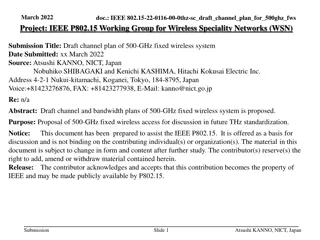Enhancing Quality of Service in Ultra High Rate Wi-Fi Networks
This document explores the potential improvements in Quality of Service (QoS) for Ultra High Rate (UHR) Wi-Fi networks, focusing on the benefits of timing information sharing for traffic urgency assessment. It discusses areas such as increased reliability, lower latencies, improved manageability, and performance enhancements in congested environments. Additionally, it addresses new use cases with extremely low latency requirements, including real-time gaming, cloud gaming, equipment control, robotics, and more. The motivation behind enhancing QoS in UHR networks is highlighted through scenarios of packet drops due to delay bounds being exceeded.
Download Presentation

Please find below an Image/Link to download the presentation.
The content on the website is provided AS IS for your information and personal use only. It may not be sold, licensed, or shared on other websites without obtaining consent from the author.If you encounter any issues during the download, it is possible that the publisher has removed the file from their server.
You are allowed to download the files provided on this website for personal or commercial use, subject to the condition that they are used lawfully. All files are the property of their respective owners.
The content on the website is provided AS IS for your information and personal use only. It may not be sold, licensed, or shared on other websites without obtaining consent from the author.
E N D
Presentation Transcript
April 2023 doc.: IEEE 802.11-23/0885r0 Considerations on QoS Enhancement in UHR Date: 2023-04-12 Authors: Name Peshal Nayak Affiliations Samsung Address Phone email p.nayak@samsung.com Boon Loong Ng Rubayet Shafin Vishnu Ratnam Yue Qi Elliot Jen Submission Slide 1 Peshal Nayak, Samsung Research America
April 2023 doc.: IEEE 802.11-23/0885r0 Abstract In this contribution, we discuss the benefits of timing information sharing for traffic urgency assessment Submission Slide 2 Peshal Nayak, Samsung Research America
April 2023 doc.: IEEE 802.11-23/0885r0 Background UHR has considered several areas of improvement for next generation Wi-Fi networks [1]: Increased reliability of WLAN connectivity Lower latencies and deterministic latency support Increased manageability and mobility support Increased performance in congested environments Throughput enhancements Power savings enhancements The approved PAR intends to consider at least one mode of operation capable of improving the tail of the latency distribution and jitter compared to EHT MAC/PHY operation [2] Submission Slide 3 Peshal Nayak, Samsung Research America
April 2023 doc.: IEEE 802.11-23/0885r0 Background Support for new use cases with extremely low latency applications have been proposed previously: A number of applications that can potentially have very low latency requirements have been considered and discussed by the group [3]-[5] Applications in these categories can have a last hop latency requirements on the scale of a few milliseconds [3], [4] Many such use cases have also been analysed in the RTA report For some of the applications near lossless performance is also expected Use cases Intra BSS latency [ms] Jitter variance [ms] Packet loss Data rate [Mbps] Real-time gaming < 5 < 2 < 0.1 % < 1 Cloud gaming < 10 < 2 Near- lossless < 0.1 (Reverse link) > 5Mbps (Forward link) Real-time video < 3 ~ 10 < 1~ 2.5 Near- lossless 100 ~ 28,000 Equipment control < 1 ~ 10 < 0.2~2 Near- lossless < 1 Robotics and industrial automation Human safety < 1 ~ 10 < 0.2 ~ 2 Near- lossless < 1 Haptic technology < 1 ~ 5 <0.2~2 Lossless <1 Drone control < 100 <10 Lossless <1 >100 with video Submission Slide 4 Peshal Nayak, Samsung Research America
April 2023 doc.: IEEE 802.11-23/0885r0 Motivation AP -> STA50 AP -> STA1 AP -> STA2 AP STA1 STA1 AP STA20 STA2 STA2 STA 20 has dropped the packet as delay bound exceeded! STA20 Spec provides a number of frameworks for scheduling STA side uplink transmission. However, AP may have many STAs associated with it. AP does not know which STA needs to be prioritized for such triggering One of the key pieces of information missing at the AP-side today is the timing information from the STA side. E.g., enqueue timestamp Knowledge of STA-side timing information can enable an AP to take timely action for an STA and ensure that its latency requirement are met. Submission Slide 5 Peshal Nayak, Samsung Research America
June 2021 doc.: IEEE 802.11-23/0885r0 Prior Work There has been discussion on this topic in TGbe [5]-[7]. Unfortunately the group could not reach consensus on this issue. A few works have also raised this issue in UHR in the context of specific features. E.g. R-TWT [8] In this presentation we provide discussion on some factors that need to be considered when designing the framework and signaling for such timing information sharing Submission Slide 6 Peshal Nayak, Samsung Research America
April 2023 doc.: IEEE 802.11-23/0885r0 Timing Information Sharing Approaches Historical data based assessment Real time assessment AP AP Based on past data, AP can predict that STA is likely to face problems in the near future and prioritizes it Based on delay bound knowledge AP can compute when packet will be dropped. Delay bound AP action was effective and no further action necessary or AP can further attempt to improve AP takes action to prevent packet drop at STA side. E.g., STA is triggered prior to the point where packet can be dropped. Two approaches to share timing information Historical data based assessment Real time assessment Submission Slide 7 Peshal Nayak, Samsung Research America
April 2023 doc.: IEEE 802.11-23/0885r0 Signalling Approaches Timing info for link 3 provided on link 1. Timing info is tagged with link ID AP1 STA1 AP1 STA1 link1 link1 AP2 STA2 AP2 STA2 link2 link2 STA3 AP3 STA3 AP3 link3 link3 Timing info for link 3 is provided on link 3 itself No need to tag the info with link ID Two approaches: Timing information can be shared in a cross link manner Timing information can be shared on the same link for which information is relevant Submission Slide 8 Peshal Nayak, Samsung Research America
April 2023 doc.: IEEE 802.11-23/0885r0 High Level Procedure STA shares timing information to the AP (same link or cross link) Based on timing information and delay bound information, AP computes how urgently STA needs to send its packet AP can prioritize STAs that has higher urgency first in any scheduling decision that it makes Submission Slide 9 Peshal Nayak, Samsung Research America
April 2023 doc.: IEEE 802.11-23/0885r0 Summary UHR intends to improve latency and reliability. Timing information can be crucial for helping the AP to reduce the latency and packet loss for uplink traffic. This presentation provides discussion on some factors that can be considered for timing information sharing in UHR Submission Slide 10 Peshal Nayak, Samsung Research America
April 2023 doc.: IEEE 802.11-23/0885r0 References [1] Beyond be Proposed Next Step, IEEE 802.11-22/0708r3 [2] UHR proposed PAR, IEEE 802.11-23/480 [3] Considerations on UHR PAR and KPIs, IEEE 802.11-22/1919 [4] Cloud VR Use Case and Requirements, IEEE 802.11-22/0952 [5] 802.11bx: Enabling Metaverse -- Metaverse, AR/VR, and Wearables, IEEE 802.11- 22/0779 [4] RTA report draft, IEEE 802.11-18/2009 [5] CR for Low-Latency BSR, IEEE 802.11-21/1577 [6] Resolution for CID 10674, IEEE 802.11-22/1454 [7] LB266 CR for CIDs 10710, 12711, IEEE 802.11-22/1278 [8] Urgency-based Delivery of Latency Sensitive Traffic, IEEE 802.11-23/0045 Submission Slide 11 Peshal Nayak, Samsung Research America
